The OCZ Vertex 3 Review (120GB)
by Anand Lal Shimpi on April 6, 2011 6:32 PM ESTAnandTech Storage Bench 2011
I didn't expect to have to debut this so soon, but I've been working on updated benchmarks for 2011. Last year we introduced our AnandTech Storage Bench, a suite of benchmarks that took traces of real OS/application usage and played them back in a repeatable manner. I assembled the traces myself out of frustration with the majority of what we have today in terms of SSD benchmarks.
Although the AnandTech Storage Bench tests did a good job of characterizing SSD performance, they weren't stressful enough. All of the tests performed less than 10GB of reads/writes and typically involved only 4GB of writes specifically. That's not even enough exceed the spare area on most SSDs. Most canned SSD benchmarks don't even come close to writing a single gigabyte of data, but that doesn't mean that simply writing 4GB is acceptable.
Originally I kept the benchmarks short enough that they wouldn't be a burden to run (~30 minutes) but long enough that they were representative of what a power user might do with their system.
Not too long ago I tweeted that I had created what I referred to as the Mother of All SSD Benchmarks (MOASB). Rather than only writing 4GB of data to the drive, this benchmark writes 106.32GB. It's the load you'd put on a drive after nearly two weeks of constant usage. And it takes a *long* time to run.
I'll be sharing the full details of the benchmark in some upcoming SSD articles but here are some details:
1) The MOASB, officially called AnandTech Storage Bench 2011 - Heavy Workload, mainly focuses on the times when your I/O activity is the highest. There is a lot of downloading and application installing that happens during the course of this test. My thinking was that it's during application installs, file copies, downloading and multitasking with all of this that you can really notice performance differences between drives.
2) I tried to cover as many bases as possible with the software I incorporated into this test. There's a lot of photo editing in Photoshop, HTML editing in Dreamweaver, web browsing, game playing/level loading (Starcraft II & WoW are both a part of the test) as well as general use stuff (application installing, virus scanning). I included a large amount of email downloading, document creation and editing as well. To top it all off I even use Visual Studio 2008 to build Chromium during the test.
Update: As promised, some more details about our Heavy Workload for 2011.
The test has 2,168,893 read operations and 1,783,447 write operations. The IO breakdown is as follows:
| AnandTech Storage Bench 2011 - Heavy Workload IO Breakdown | ||||
| IO Size | % of Total | |||
| 4KB | 28% | |||
| 16KB | 10% | |||
| 32KB | 10% | |||
| 64KB | 4% | |||
Only 42% of all operations are sequential, the rest range from pseudo to fully random (with most falling in the pseudo-random category). Average queue depth is 4.625 IOs, with 59% of operations taking place in an IO queue of 1.
Many of you have asked for a better way to really characterize performance. Simply looking at IOPS doesn't really say much. As a result I'm going to be presenting Storage Bench 2011 data in a slightly different way. We'll have performance represented as Average MB/s, with higher numbers being better. At the same time I'll be reporting how long the SSD was busy while running this test. These disk busy graphs will show you exactly how much time was shaved off by using a faster drive vs. a slower one during the course of this test. Finally, I will also break out performance into reads, writes and combined. The reason I do this is to help balance out the fact that this test is unusually write intensive, which can often hide the benefits of a drive with good read performance.
There's also a new light workload for 2011. This is a far more reasonable, typical every day use case benchmark. Lots of web browsing, photo editing (but with a greater focus on photo consumption), video playback as well as some application installs and gaming. This test isn't nearly as write intensive as the MOASB but it's still multiple times more write intensive than what we were running last year.
As always I don't believe that these two benchmarks alone are enough to characterize the performance of a drive, but hopefully along with the rest of our tests they will help provide a better idea.
The testbed for Storage Bench 2011 has changed as well. We're now using a Sandy Bridge platform with full 6Gbps support for these tests. All of the older tests are still run on our X58 platform.
AnandTech Storage Bench 2011 - Heavy Workload
We'll start out by looking at average data rate throughout our new heavy workload test:
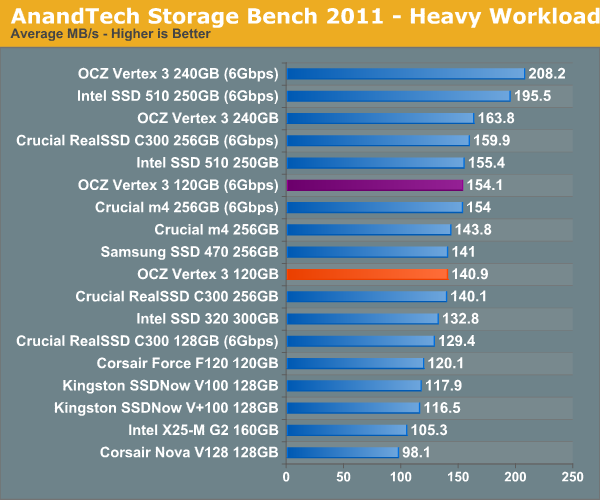
In our heavy test for 2011 the 120GB Vertex 3 is noticeably slower than the 240GB sample we tested a couple of months ago. Fewer available die are the primary explanation. We're still waiting on samples of the 120GB Intel SSD 320 and the Crucial m4 but it's looking like this round will be more competitive than we originally thought.
The breakdown of reads vs. writes tells us more of what's going on:

Surprisingly enough it's not read speed that holds the 120GB Vertex 3 back, it's ultimately the lower (incompressible) write speed:
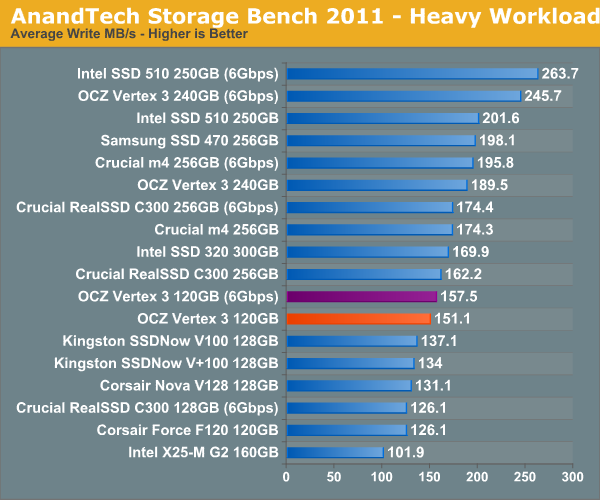
The next three charts just represent the same data, but in a different manner. Instead of looking at average data rate, we're looking at how long the disk was busy for during this entire test. Note that disk busy time excludes any and all idles, this is just how long the SSD was busy doing something:
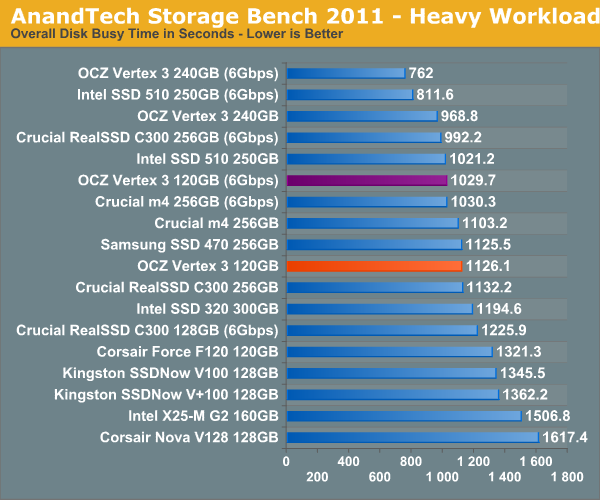
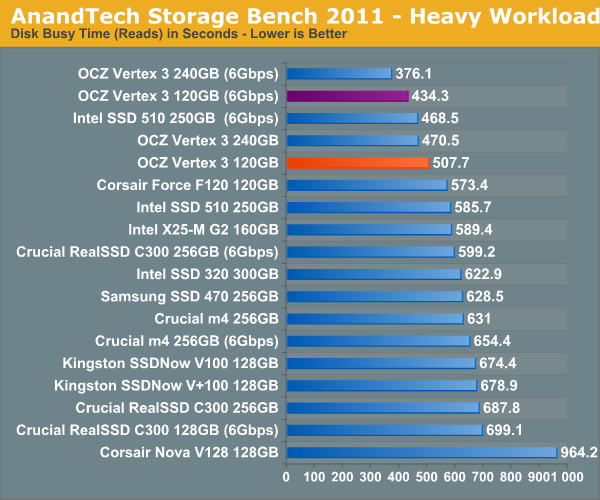
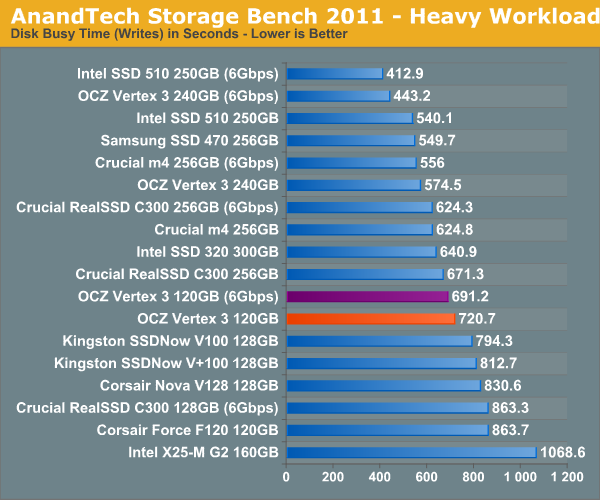










153 Comments
View All Comments
sor - Thursday, April 7, 2011 - link
Oh sure, I agree that the bottom line is whether or not it still works, that's why they do the binning and have grades of product within that brand. If OCZ can use cheaper flash and the controller takes care of the increased failures, or the users never reach the failure threshold, then who cares, as long as the product works the same?I can't speak for the testing procedures within SpekTek or their tolerances, as I only worked for a facility that tested parts for Micron, and in the process generated the bad parts and did some of the binning before sending them to SpekTek. Much of the stuff that went to them failed our tests but was otherwise not physically damaged.
There's a reason why those parts are sold under the SpecTek brand at a discount, it shows that even the manufacturer doesn't trust them to be sold under the good brand after testing.
Panlion - Thursday, April 7, 2011 - link
I wonder if OCZ will produce a 7mm 2.5 inch drive. The newer notebooks from Lenovo are starting to demand that format it'll be nice if I can have some option other than Intel SSD.sleepeeg3 - Thursday, April 7, 2011 - link
Maintaining integrity while sticking out for the little guy, instead of bending over backward to write glowing articles for every vendor sponsor. That's what has made this site succeed.I wish you could also take OCZ to task on SandForce's controller strange tendency to lock up and vanish from a system, due to built in encryption. They are in complete denial that it is an issue, despite dozens of reports on their user forums.
edfcmc - Thursday, April 7, 2011 - link
Thank you Anand for this very informative and in-depth review of the OCZ issue and their latest 120gb vertex 3 product; especially since the 120gb products are within my price range and the size I am looking to purchase. On a side note, I have been reading your reviews since your review of the FIC PA-2007 many years ago and I love the evolution of this site and your dedication to keeping us consumers informed.p.s. Please consider asking asus/Nvidia to update the Nvidia driver on their ULV80 series as nothing new has been updated since I purchased the UL80vt based on this site's recommendation. Asus/Nvida seem to be a little non-responsive to us folks who have been requesting an update for quite some time.
ekerazha - Thursday, April 7, 2011 - link
Can't wait for reviews of SSDs (Intel G3, Crucial m4) with comparable size (120 GB).Chloiber - Thursday, April 7, 2011 - link
Anand:Just a quick note. In the newest SF-firmware, there is also still a bug with Hynid Flash. You can see it here, under "Open Issues":
http://www.ocztechnologyforum.de/forum/showthread....
"Under benchmarking scenarios with IOMETER 2006, 60GB drives that use Hynix32nm MLC (1024 blocks, 8KB pages) can impose long latencies"
Just FYI.
MarcHFR - Thursday, April 7, 2011 - link
Dear OCZ, Dear Anand,In the past, it was simple :
Vertex : always the same NAND
Agility : NAND could change
I know that Vertex name is a best seller for OCZ, but i think it will be simplier to back to this
strikeback03 - Friday, April 8, 2011 - link
That is what I was wondering, I thought the point of the Agility line was that they would use the good controller but possibly cheaper NAND.Adul - Thursday, April 7, 2011 - link
Why not make use of QOR codes so a shopper can just scan the code to be taken to a page with more detail information.miscellaneous - Thursday, April 7, 2011 - link
Given this particularly insidious paragraph:"OCZ will also continue to sell the regular Vertex 2. This will be the same sort of grab-bag drive that you get today. There's no guarantee of the NAND inside the drive, just that OCZ will always optimize for cost in this line."
Will these "grab-bag" drives be using the same SKU(s)/branding as the original - well reviewed - Vertex 2? If so, how is using the _old_ SKU(s) to identify the _new_ "grab-bag" drives, whilst introducing _new_ SKU(s) to help identify drives with the _old_ level of performance a satisfactory solution?